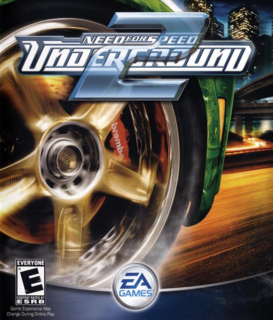Overall, the racing is quite fun, and the game is enjoyable while it is fresh.
For the sequel, EA has added an open world feature to the gameplay. Like in Grand Theft Auto III, Need for Speed Underground 2 features a vibrant and immersive city called Bayview. The fictional city, like Liberty City, is comprised of distinct districts. There is an industrial district, a casino area in the city core, an airport, offcity hills featuring winding roads, and other landmarks such as a baseball stadium and sports arena. You'll have to drive to race locations, which are marked by icons, in order to enter them. The actual races are on tracks made up of different segments of the city. During the races, paths are blocked off with flashing arrows, so you can't take a completely different route. When you're not racing though, you can have the freedom of driving anywhere and exploring the city. The more you play, the more familiar you'll be with the various locations in the city.
The career mode involves a loosely tied story, and involves you trying to extract revenge against a rival street racer named Caleb. In order to do so, you'll need to win enough races and gain reputation to have the opportunity to race against Caleb. Brooke Burke plays Rachel Teller, a young woman who helps you throughout the game. The game communicates information to you with mobile messages from Rachel. These appear in the SMS interface, which also has maps of Bayview and race locations, as well as your game progress stats. The SMS interface also allows you to access the GPS, which is a cool feature that allows you to select a race location on the map, and an arrow will appear that guides you to that location. For the most part, the GPS indicates the fastest route to your destination, and unlike the arrow in Crazy Taxi, will account for the actual route you'll need to take, and not just indicate the general direction. It's too bad that you can only select race locations to engage the GPS. It would have been nice to be able to mark any location on the map and have the GPS point you there.
In order to win races and earn cash, you'll have to upgrade your car with performance enhancing parts. Also, by increasing your car's visual rating, you'll gain access to special events to win more cash. Different types of shops around Bayview offer different ways to upgrade and customize the look of your car. Performance shops allow you to purchase performance upgrades to your car, such as engine parts, transmission, tires, and brakes. Body, specialty, and graphic shops allow you to modify the look of your car by applying paint, decals, sponsor logos, and installing parts such as spoilers, rims, and roof scoops.
In order to advance in the career mode, you'll have to win a predetermined number of races to advance to the next stage of the game, where more of the city is unlocked and more parts are available at the stores. Circuit, sprint, drag, and drift races return from the previous game, but there are a few new race types. There are now drift races on open mountain tracks, in addition to the closed track variety. Street X races are circuit races that take place on drift tracks, and Underground Racing League events are circuit races on actual race tracks and at the airport. Also new are outrun races, which work like the races in Tokyo Xtreme Racer, where the goal is to establish a lead of a certain distance on your opponent. Outrun races are a bit different from the other events, since they are initiated by driving around the city in the free roam mode, and looking for rival cars. This is another way that the game makes use of its open world aspect.
Need for Speed Underground 2 introduces a couple of concepts that are borrowed from other racing games. As mentioned, the outrun races are from Tokyo Xtreme Racer, but it also incorporates the nitrous refilling system in Burnout. After upgrading your car with a nitrous system, you can refill it during races by driving dangerously, such as near accidents, performing powerslides, drafting, and driving clean sections and laps.
Visually, the game is impressive. Bayview is richly detailed, the cars look great, and the game adds rain and weather effects with drops on the screen, simulating rain on a windshield. While the city is atmospheric and immersive, Need for Speed Underground 2 also has the most noticeable product placing in a video game I've seen. As you drive around the city, you'll see billboards featuring ING Direct, Burger King, Best Buy, AutoZone, and Cingular, as well as other companies. Even the onscreen SMS interface bears Cingular's logo.
There are some problems with the game. The career mode drags on much too long, and eventually you'll be running what seems like the same courses over and over again. The free roaming concept is interesting, but ultimately doesn't add to the game. Rather, it drags the game out longer, as you'll spend way too much time driving to races. Although it is clear that Need for Speed Underground 2 isn't a realistic driving simulation, the collision model is still laughable and unrealistic. In most cases, running into a wall at a sharp corner is just as good as reducing speed and proper cornering. Big crashes are played out in slow motion, and your car gets way too much airtime in crashes. The soundtrack is quite forgettable, and there's little variety in it.
If you've played the previous game, you'll know what to expect from Need for Speed Underground 2. Overall, the racing is quite fun, and the game is enjoyable while it is fresh.

